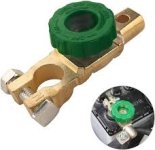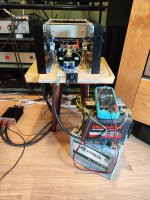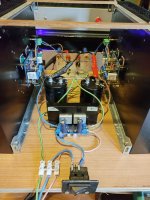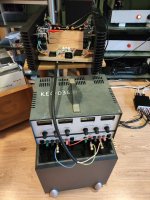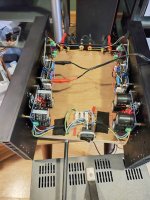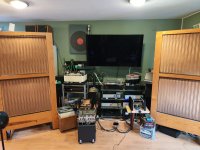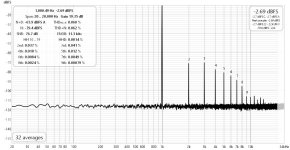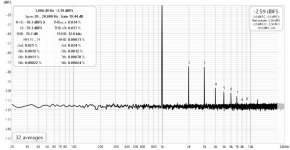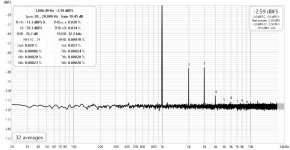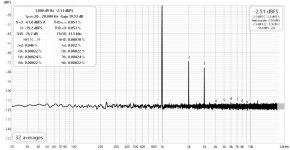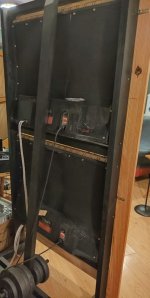Well, the standard solution, as published by Hiraga, uses a transformer and rectifiers etc. to charge up the caps first.

Probably slightly higher voltage than the batteries.
Switching then takes place across a very small voltage difference.
I have already explained why we don't want to do that.
So we'll still need to have inrush control.
Patrick
Probably slightly higher voltage than the batteries.
Switching then takes place across a very small voltage difference.
I have already explained why we don't want to do that.
So we'll still need to have inrush control.
Patrick
If I want a cap in addition to a battery, I want it close to the amp, with short, non-inductive connecting cables.
Not next to the battery.
A switch after the caps but close to the amp can only be a relay or MOSFET switch.
(We have separate caps for each channel.)
Can be done, if necessary.
Patrick
Not next to the battery.
A switch after the caps but close to the amp can only be a relay or MOSFET switch.
(We have separate caps for each channel.)
Can be done, if necessary.
Patrick
It has taken a little while, but finally we are ready to go.
LM Original uses original set of transistors, with normal passive components (Vishay Dale, Bourns, Fukushima MPC74, etc.)
2x 12V car battery power, 2x 150,000µF EPCOS electrolytic's, low Rdson MOSFET inrush as detailed before.
LM Modern uses currently produced transistors as much as possible, with same set of passive components.
Lab supplies +/-15V followed by high-power Didden Super Regulator.
The rest I leave it to Fran and his panel. 😊
Patrick
.
LM Original uses original set of transistors, with normal passive components (Vishay Dale, Bourns, Fukushima MPC74, etc.)
2x 12V car battery power, 2x 150,000µF EPCOS electrolytic's, low Rdson MOSFET inrush as detailed before.
LM Modern uses currently produced transistors as much as possible, with same set of passive components.
Lab supplies +/-15V followed by high-power Didden Super Regulator.
The rest I leave it to Fran and his panel. 😊
Patrick
.
Attachments
Some distortion measurements at start up.
They change somewhat when fully warmed up, especially the originals.
All thanks to Fran.
Patrick
.
They change somewhat when fully warmed up, especially the originals.
All thanks to Fran.
Patrick
.
Attachments
Well, the standard solution, as published by Hiraga, uses a transformer and rectifiers etc. to charge up the caps first.
...
Probably slightly higher voltage than the batteries.
I suspect the Hiraga circuit also can keep the batteries fully charged.
According to Jean HIRAGA himself, the preference for a low value of Idss (which corresponds to the 'Y' classification of JFETs) is that the greater the value of Idss, the greater the gate leakage current Igs. By going from 3 mA to 1 mA, the value of the Gate-Source current leakage (IGS) decreases significantly, which leads to a clear gain in transparency. And still according to Jean, the Hitachi 2SA872 and 2SC1775 bipolars sound much better than those available today.
two pairs of ESL 57 mounted in common chassis!
I'll be curious to see the back.
nice montage, I would have liked to have been there to listen to all of this.
According to Jean HIRAGA himself, the preference for a low value of Idss (which corresponds to the 'Y' classification of JFETs) is that the greater the value of Idss, the greater the gate leakage current Igs.
IMHO, the most effective way of reducing gate leakage is reducing Vds, e.g. by lowering the cascode voltage.
Cheers,
Patrick
For information, what are the hFE values of the output transistors 2SB754 and 2SD844 @0.6A in the test amplifier?
Myself and three seasoned audiophile friends spent most of today listening to two versions of the Le Monstre. The first of these was as close as possible to the original (with the exception of the 2SK170Y/2SJ74Y which are truly unobtainium) powered from two car batteries via 160,000uF per channel. The second is a modern version with all currently available components, and this was powered via a Didden super regulator adjusted for high current supplied from a lab bench supply. Both amps were fed through a mosfet based A-B switching device to allow switching of the amps on the fly. The source was AD1862 DAC through an 01A preamp and the speakers were stacked quad 57 ESLs. Each person got to sit in the hot chair for extended periods, listening to music they were more or less familiar with, and could switch between amps via a remote control for the A-B switch. As we listened, we made sure to play a wide variety of music to cover all bases and tastes.
Overall the amp sounds really good - great bass attack, smooth vocals and highs, it really has a nice sound - and you have to bear in mind these little ~7-8W amps were driving stacked ESL57s, hardly the kindest of loads. However, it was clear from the start that there were only very minor differences between the two amps. In general, comments from all listeners were consistent - there was a slight difference in sound between both amps, and this was almost imperceptible with some tracks, and more noticeable with others. The original version had a slightly narrower soundstage (left to right) but also sounded just a little softer, most noticeable on vocals which had a harder edge. By comparison the modern version was just a little more defined, and had tighter bass. It sounds from this that these were clearly heard distinctions - they absolutely were not. The differences were tiny, and I think if the A-B switch was not in place we would never have been able to tell the difference. Each of us were really searching for differences as tracks played - not the normal way anyone would listen to music and I think its really important to emphasise how small the differences were.
A third version of this amp is similar to the original which is now known as the Le Monstre Deluxe, is fitted with passives close to those recommended by Jean Hiraga - tantalum resistors and wire wound pots. We did not have time today to compare this deluxe build with the originals - this will be done in a future session. For now, I am clear that there is almost no difference in these first two versions, despite the vastly different power supplies, and I think avoiding the use of large, heavy and awkward car batteries is a no-brainer. A part of me wants to listen to the original version with the same power supply as the modern version to see if those differences disappear completely
Overall the amp sounds really good - great bass attack, smooth vocals and highs, it really has a nice sound - and you have to bear in mind these little ~7-8W amps were driving stacked ESL57s, hardly the kindest of loads. However, it was clear from the start that there were only very minor differences between the two amps. In general, comments from all listeners were consistent - there was a slight difference in sound between both amps, and this was almost imperceptible with some tracks, and more noticeable with others. The original version had a slightly narrower soundstage (left to right) but also sounded just a little softer, most noticeable on vocals which had a harder edge. By comparison the modern version was just a little more defined, and had tighter bass. It sounds from this that these were clearly heard distinctions - they absolutely were not. The differences were tiny, and I think if the A-B switch was not in place we would never have been able to tell the difference. Each of us were really searching for differences as tracks played - not the normal way anyone would listen to music and I think its really important to emphasise how small the differences were.
A third version of this amp is similar to the original which is now known as the Le Monstre Deluxe, is fitted with passives close to those recommended by Jean Hiraga - tantalum resistors and wire wound pots. We did not have time today to compare this deluxe build with the originals - this will be done in a future session. For now, I am clear that there is almost no difference in these first two versions, despite the vastly different power supplies, and I think avoiding the use of large, heavy and awkward car batteries is a no-brainer. A part of me wants to listen to the original version with the same power supply as the modern version to see if those differences disappear completely
The (minute) difference between the two can be explained as follows :
The two channels of the LM original were fed by the same car batteries and 150000uF caps. The LM modern, though also from the same lab supply, has separate Didden power regulators. This can explain the better separation. Of course, in a proper build later, one can use separate transformers, or at least separate secondaries, for the two channels for even better separation.
The power transistors in the LM modern have a hfe of 105, compared to 85 of the LM original. The driver transistors of LM modern has a hfe of 440, compared to those of the original of ~300. This results in higher open loop gain, and thus more negative feedback, and hence better bass control. But the LM modern has slight ringing, requiring the additional 47p Ccom at the driver transistors.
The feedback from Fran & co. means that anyone can build the LM modern with obtainable components without paying extra for NOS parts. and still results close enough to the original.
The original Hiraga PCB has already been published.
https://www.diyaudio.com/community/threads/hiraga-le-monstre-2024.413301/post-7696593
Now we'll wait anxiously for the comparison with the LM Deluxe with all exotic passives.
Patrick 🤓
The two channels of the LM original were fed by the same car batteries and 150000uF caps. The LM modern, though also from the same lab supply, has separate Didden power regulators. This can explain the better separation. Of course, in a proper build later, one can use separate transformers, or at least separate secondaries, for the two channels for even better separation.
The power transistors in the LM modern have a hfe of 105, compared to 85 of the LM original. The driver transistors of LM modern has a hfe of 440, compared to those of the original of ~300. This results in higher open loop gain, and thus more negative feedback, and hence better bass control. But the LM modern has slight ringing, requiring the additional 47p Ccom at the driver transistors.
The feedback from Fran & co. means that anyone can build the LM modern with obtainable components without paying extra for NOS parts. and still results close enough to the original.
The original Hiraga PCB has already been published.
https://www.diyaudio.com/community/threads/hiraga-le-monstre-2024.413301/post-7696593
Now we'll wait anxiously for the comparison with the LM Deluxe with all exotic passives.
Patrick 🤓
Last edited:
I note that the harmonic distortion (H2 versus H3) does not reflect that put forward by Jean HIRAGA about the JFET and BJT cascode assembly at the input, whether it is the version close to the original or the modern one.

vs


vs
It is not clear to me what those figures refer to, whether it is the Le Monstre, or the Hiraga 20W.
https://sound-au.com/tcaas/monster27.htm
It is also not clear what load, power level, and frequency.
All those parameters can change the distortion spectrum.
But of course, if you know from experience what else we could do to match that, we are happy to oblige.
Maybe we should deliberately mismatch all the transistors.
This will most certainly increase the 2nd harmonic distortion.
Best regards,
Patrick
https://sound-au.com/tcaas/monster27.htm
It is also not clear what load, power level, and frequency.
All those parameters can change the distortion spectrum.
But of course, if you know from experience what else we could do to match that, we are happy to oblige.
Maybe we should deliberately mismatch all the transistors.
This will most certainly increase the 2nd harmonic distortion.
Best regards,
Patrick
Last edited:
- Home
- Amplifiers
- Solid State
- Hiraga Le Monstre 2024
